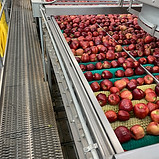Ozone Applications Overview
Ozone is a safe and sustainable sanitizer/disinfectant utilized for direct food contact and no-rinse sanitation for food contact and non-food contact surfaces in either its aqueous or gaseous form.

Sanitation
Conventional cleaning and sanitation in food processing plants has revolved around heavy use of chemicals and hot water. While this approach has considerable downsides, e.g., safety, costs, chemical inventory, complexity, etc., it was also the only way to meet strict standards set forth by government, customer audit compliance, and HACCP programs. Ozone can replace the conventional sanitation techniques used in the food processing industry. Ozone technology is presently being used for food contact surface and direct product sanitation worldwide.
Ozone dissolved in water (aqueous ozone) is used to sanitize both food-contact and non-food contact surfaces with handheld or continuous flow low-pressure sprayers. It can be used on-demand, or can be configured to operate automatically under a diverse set of arrangements. Ozone use will reduce fat, oil & grease, and break down biofilm build-up on all surfaces, including floor drains, creating no adverse effect on waste water treatment systems. Microorganisms cannot develop a tolerance to ozone, so no sanitizer rotation is necessary. Aqueous ozone is safe for facility workers and for all surfaces. Over time it will help to rid drains and adjacent plumbing of biofilm, and other harmful microorganisms such as Listeria species, that can migrate back into the processing area.
Ozone sanitation is extremely effective at keeping conveyor belts clean and free of build-up. “Build-up” may consist of food debris, sugar, fat, grease, etc., while at the same time harboring biofilm that may consist of any number of food and human pathogens as well as a multitude of fungi (mold and yeast), all of which are difficult to control in many food processing environments. Aqueous ozone spray can be used before, during, or after processing. Ozone is an approved food additive (including organic approval), which means it can be used simultaneously during any process. This is beneficial because it helps to eliminate any build-up before it starts. Many conveyors are inconspicuously harboring substantial biofilm, and the use of aqueous ozone will remove it almost instantaneously and then keep it away.

Quality
Ozone (aqueous and gaseous) can be used for direct product treatment on fruits, vegetables, raw and ready-to-eat (RTE) meat and poultry, fish, and eggs. Fully USDA, National Organic Program, and FDA approved for direct food contact, ozone provides the highest level of product sanitation. Ozone is also environmentally friendly, completely sustainable, and 100% organic certified. In use, ozone provides highly effective reduction of spoilage and pathogenic microorganisms.
Integrated into any aqueous operation, ozone can be used for direct product treatment on fruits, vegetables, raw and ready-to-eat (RTE) meat and poultry, fish, and eggs. Since ozone is an approved antimicrobial food additive, it can be simultaneously applied at any time during processing on the product and equipment.
Ozone gas can be used in closed environments, such as refrigerated storage rooms, to directly treat all airborne and surface-borne microorganisms. This can be particularly useful for treatment of environmental Listeria species in hard to reach areas in a variety of food spaces. Ozone gas is commonly used to control mold and ripening on a variety of fruits and vegetables in cold storage.
Gaseous ozone systems are designed to automatically introduce ozone with setpoint control using state-of-the-art ozone monitoring equipment. The ozone systems are based on a revolutionary new design utilizing individual ozone generation units each with a dedicated ozone concentration analyzer for unprecedented ozone level control at each application area. The systems include integrated ozone concentration monitor utilizing UV absorption technology and oxygen purity monitor. System operation is via a Python computer controller with tablet user interface, providing automatic setpoint controlled operation. All historical treatment data, in addition to system diagnostic data and alarming, is stored in the computer and accessible remotely.
